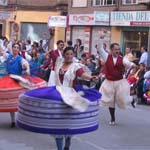Spring Fiestas of Murcia
The Fiestas de la Primavera (Spring Fiestas) are celebrated in Murcia and are the recreational continuation of the Easter celebration, much more religion-oriented and introspective. It consists of two different celebrations that date back from 1849, and which are the Bando de la Huerta (literally, the Edict of the Orchard) and the Burial of the Sardine.
Bando de la Huerta
The first of the Spring Fiestas is the Bando de la Huerta, Murcia's big day of fiesta, and happens on the first Tuesday after Easter. Although it started as a mockery from some of the local well-off youngsters of the farming world, nowadays is the exact opposite: an exaltation of Murcia's fertile region and its agricultural traditions.

The celebration begins with the so-called "Orchard Mass" outside the city's cathedral, which is followed by a beautiful procession in which the image of the Virgin of Fuensanta, the patron saint of the city, is exhibited. In the most important squares and parks of the city, the local associations set up marquees in which the traditional food from Murcia is offered, like the zarangollo or the michirones. There are also traditional dances in some of them, and others serve as a display for exact reproductions of the typical houses of the farmers of the area.
Then, in the afternoon, the Orchard Parade takes place: it is a lively and joyful passacaglia in which there are typical dances (the jotas), Giants and Big-Heads, anmd carriages which display the traditional work tools of the farming world. Eating and drinking keeps going on throughout the parade, and the soflamas panochas are recited from the carriages. These are a form of satirical texts written in the vernacular language of the Murcia region, the panocho.
The Bando de la Huerta is a colourful celebration in which the whole city takes part, wearing the traditional costumes and spending a day of fun in honour of Murcia's fertile region.
Entierro de la Sardina
The Burial of the Sardine is the climax of the celebration. It is an allegory of the triumph of Mr. Carnival over Mrs. Lent, as if the Carnival was returning to wash away the time of privation and fasting of the Lent and the Easter. It also has a strong association with old pagan myths related with fire and its purifying power.

The present form of the celebration took shape in the mid-XIX century, when a group of students organized a mock funeral for a sardine. The Burial of the Saridne caught on the people of Murcia and nowadays is a Fiesta of International Tourist Interest.
The structure of the event is divided in three parts:
- The arrival of the sardine, which is brought from a nearby village, and every year a different means of transportation is used. In the last years it has been transported on a balloon, a paraglide, a firemen truck and even a helicopter.
- The reading of the Testament of the Sardine: carried out by Doña Sardina, it usually contains numerous references to the current political and social situation.
- A parade that goes out on Murcia's streets on Saturday night of the festive week, in which take parts different orchestras and krewes, and carriages dedicated to the Olympic gods. Acting as the godparents of the late sardine there are elected two popular celebrities or local politicians, which receive the names of Gran Pez (Big Fish) and Doña Sardina (Mrs Sardine).
Once the parade is over, the culmination of the festivity arrives when the Sardine (usually made out of wood and paper mache) is burned next to the Puente Viejo, after which a fireworks spectacle sees out the celebrations.

 The celebration of the ways and traditions of Murcia's fertile region, the Spring Fiestas sum up the city's history and roots.
The celebration of the ways and traditions of Murcia's fertile region, the Spring Fiestas sum up the city's history and roots. 